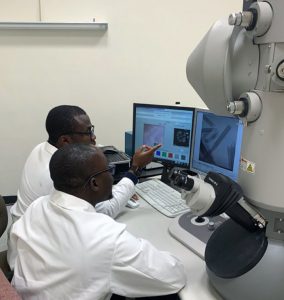Study Reports Advancement in Environmentally-Friendly Dispersant Technology
– NOVEMBER 14, 2019
University and industry scientists are developing a benign alternative to chemical dispersants used for oil spill response, such as COREXIT used during Deepwater Horizon. Their earlier investigations revealed that halloysite clay particles, a natural material, that are filled with surfactants provide an effective delivery vehicle of dispersants to an oil slick. The team can now form a thin skin around the halloysite’s nanotubes, the area where the surfactants are encapsulated, enabling a slow and targeted release of the surfactants and enhancing small oil droplet formation and stabilization in the water column. This technological advancement provides a more efficient means for dispersant delivery by directly targeting the oil-water interface and can potentially minimize the volume of dispersants needed in a response situation. The concepts and scalability of this process have implications for the controlled delivery of pharmaceuticals, pesticides, and plant nutrients.
The researchers published their findings in ACS Applied Nano Materials: Stoppers and skins on clay nanotubes help stabilize oil-in-water emulsions and modulate the release of encapsulated surfactants.
The research team’s earlier investigations to create particle-stabilized emulsions using tubular natural clays (halloysites) revealed a challenge: There was an almost instantaneous release of surfactants when introduced to the oil-water interface. This quick release is a drawback as it implies that surfactant-loaded halloysite nanotubes must be delivered as a dry material, while dispersants are traditionally sprayed as a liquid solution onto an oil slick. Therefore, the team tested a means of stoppering the nanotubes to prevent a premature release of surfactants from the halloysite nanotubes.
The team prepared a stoppering agent using an environmentally benign two-dimensional metal−organic framework formed by combining iron (Fe) with a polyphenolic. Using Cryo-scanning electron microscopy for high-resolution visualization, they observed that the metal−phenolic network forms a skin around the halloysite nanotubes that effectively sequesters the surfactant for a controlled release at neutral pH values. To dissemble the metal-phenolic network and allow a gentle release, the team changed the pH conditions to an acidic value, which could be performed just before delivery to an oil spill. Adjusting the level of metal-phenolic networks can also help control the release.
Comparison experiments verified the stoppering aspect of the metal-phenolic networks. Without the stoppers, the loaded halloysites release all its surfactant (Tween 80) in less than an hour. With the stoppers, the metal-phenolic networks gradually dissemble which facilitates a slow surfactant release over 12 hours. The emulsion characteristics after disassembly show a reduction in droplet size with all droplets being smaller than 100 μm that are sustainable in the water for extended periods.
“The controlled release of surfactants from these delivery vehicles at the oil-water interface through the use of sustainable and stimuli-responsive materials that act as stoppers and skins is an advancement in oil spill science,” explained study author Vijay John. “The dispersant systems are designed to avoid the use of organic solvents and can be readily formulated with the clay nanotubes containing encapsulated surfactants simply dispersed in water. The potential to reduce dispersant use and to use dispersants more effectively is of interest in oil spill remediation.”
Data for this study are publicly available through the Gulf of Mexico Research Initiative Information & Data Cooperative (GRIIDC) at DOI 10.7266/n7-ryhg-mp19.
The study authors are Olakunle Francis Ojo, Azeem Farinmade, James Trout, Marzhana Omarova, Jibao He, Vijay John, Diane A. Blake, Yuri M. Lvov, Donghui Zhang, Duy Nguyen, and Arijit Bose.
Read summaries about related research:
- Study Demonstrates How Natural Clay Particles Enhance Oil Dispersion and Biodegradation
- Study Assesses a New Class of Safer, More Effective Dispersants
- Study Finds Clay Nanotubes Yield More Efficient Oil-Water Emulsions than Spherical Particles
- Study Finds Ecofriendly Clay Delivers and Improves Oil Spill Treating Agents
- Grad Student Owoseni Uses Small Particles to Tackle Large Spills
By Nilde Maggie Dannreuther. Contact maggied@ngi.msstate.edu with questions or comments.
************
This research was made possible in part by grants from the Gulf of Mexico Research Initiative (GoMRI) to Tulane University for the project The Design of Synergistic Dispersant and Herding Systems using Tubular Clay Structures and Gel Phase Materials. Other support included the State of Louisiana Board of Regents, Nalco-Champion Corporation, and the National Science Foundation (NSF: 1826146).
The Gulf of Mexico Research Initiative (GoMRI) is a 10-year independent research program established to study the effect, and the potential associated impact, of hydrocarbon releases on the environment and public health, as well as to develop improved spill mitigation, oil detection, characterization and remediation technologies. An independent and academic 20-member Research Board makes the funding and research direction decisions to ensure the intellectual quality, effectiveness and academic independence of the GoMRI research. All research data, findings and publications will be made publicly available. The program was established through a $500 million financial commitment from BP. For more information, visit https://gulfresearchinitiative.org/.
© Copyright 2010-2019 Gulf of Mexico Research Initiative (GoMRI) – All Rights Reserved. Redistribution is encouraged with acknowledgement to the Gulf of Mexico Research Initiative (GoMRI). Please credit images and/or videos as done in each article. Questions? Contact web-content editor Nilde “Maggie” Dannreuther, Northern Gulf Institute, Mississippi State University (maggied@ngi.msstate.edu).






